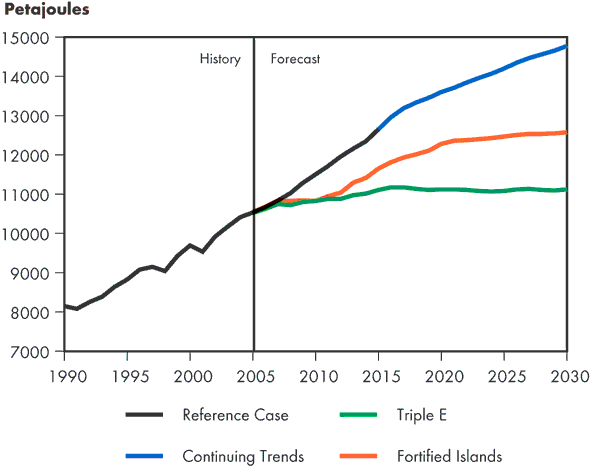ARCHIVED - Fact Sheet - Canada's Energy Future: Reference Case and Scenarios to 2030 - Energy Demand Highlights
This page has been archived on the Web
Information identified as archived is provided for reference, research or recordkeeping purposes. It is not subject to the Government of Canada Web Standards and has not been altered or updated since it was archived. Please contact us to request a format other than those available.
Fact Sheet - Canada's Energy Future: Reference Case and Scenarios to 2030 - Energy Demand Highlights
Energy demand in Canada will continue to grow as Canada's population and economy increases. Despite the growth in demand, the energy being consumed will be used more efficiently than in the past.
1. Energy demand will continue to grow despite higher energy prices than previously experienced.
Energy demand will grow at a rate of between 0.3 per cent and 1.4 per cent, per year across the three scenarios. This is down slightly from the Reference Case which shows a growth of 1.8 per cent, per year between 2004 and 2015. The lowest demand rate is in the Triple E scenario. This is because of the many government programs to promote energy efficiencies as well as environmental influences.
Canadian Total Secondary Energy Demand

Emerging technologies and alternative energy resources are growing and fulfilling some demand requirements in Canada. Wind generation in particular makes the most gains in the Triple E scenario. Infrastructure investment will be needed to continue to bring more of these resources to market, but the environmental advantages of these resources make the investment worthwhile.
Although there are gains in the growth of these emerging and alternative energy sources, they do not play a large role in meeting Canadian demand. Even in the Triple E scenario, the share of demand is still relatively small compared to conventional energy sources. Conventional energy sources will continue to be the dominant source for energy.
Energy prices in all of the scenarios will be higher than experienced in previous years. A return to the lower energy prices of the 1990s will not take place, but in two of the scenarios there will be a decline in price compared to what Canadians are currently paying. This takes place in both the Triple E and Continuing Trends scenarios. In the Fortified Islands scenario, Canadians could expect to pay more for energy than what they are paying today.
2. The oil sands industry will continue to have high energy demands.
With the growth in oil sands production in all three of the scenarios, energy demand to fuel this development will also grow. Natural gas is the primary fuel for the oil sands and it is expected that demand for natural gas will grow.
Although oil sands development relies heavily on natural gas, those companies working in the oil sands are looking for ways to reduce their dependency on natural gas. This includes the gasification of bitumen residue, the in-situ combustion of bitumen, and the use of solvents in vapour extraction methods and as an additive in steam injection projects. Geothermal and nuclear energy are also being considered as possible sources of energy for the oil sands.
The oil sands developers have managed to improve their energy efficiency at a rate of about one per cent per year for the past decade. This improvement is expected to continue in both the Fortified Islands and Continuing Trends scenarios as well as in the Triple E scenario at a rate of 1.5 per cent, per year because of energy demand management programs.
3. Energy intensity is expected to improve.
Energy intensity is the amount of energy used per unit of real GDP. An improvement in energy intensity means energy is being used more efficiently to produce goods and services. This intensity improvement occurs in all three scenarios outlined.
The Triple E scenario sees the greatest improvement of 1.9 per cent annually. This is well beyond the historical rate of one per cent per year. The improvement in the Triple E scenario is because energy demand strategies, including improved fuel efficiency, are used.
In the Fortified Islands and Continuing Trends scenario, energy intensity improves by 1.1 per cent per year. This slight improvement over historical rates is in part a result of higher energy prices going forward. Consumers adopt more energy efficiency measures and use the most of existing equipment.
Conclusion
Although there is growth in demand, Canadians will not be short on energy supply. The Canadian markets are working well and will continue to ensure there is enough supply to meet the demand. Canadian consumers are adjusting to higher energy prices. As for the range of options for fuel sources, what is available will also be determined by price and consumer preferences.
- Date modified:
